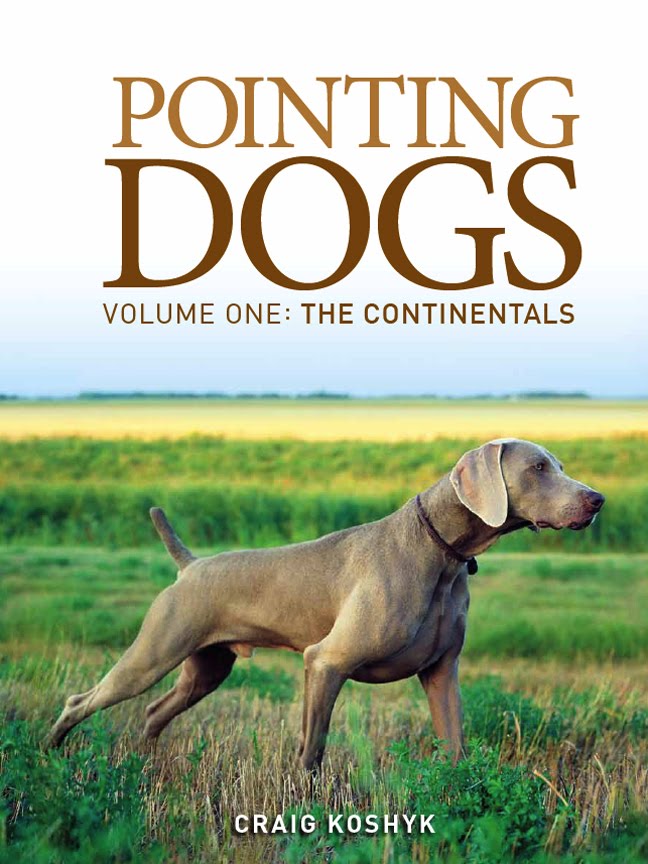Point! ....Now what?
So there you are, just you and your dog.
You are in a perfect field, on a perfect day,
hunting partridge.
Suddenly your dog slams on point.
Your heart beat quickens. You make your way to him.
When you finally get there..
What do you do?
You are in a perfect field, on a perfect day,
hunting partridge.
Suddenly your dog slams on point.
Your heart beat quickens. You make your way to him.
When you finally get there..
What do you do?
Hunters from all over the world love watching dogs search for game. And while they may have different views on just how far or how fast a dog should run, they all agree that a pointing dog's job before the shot is to hunt, find and point hidden game. And what hunters want a dog to do after the shot also varies. Some want their dogs to retrieve the game, others do not.
However, there is a wide variety of expectations to how a dog should behave after a point is established but before the game is flushed.
So there you are, your dog is on point,
you've managed to make your way to the dog and are ready to shoot.
So what does the dog do now?
If you are in North America, the answer is 'nothing'. North American hunting traditions and field trials rules generally demand that once the dog is on point, it should remain as still as a statue as the hunter or handler moves in front to flush the game. Here is a video clip showing this method as used in the hunting field:
And here it is in a field trial:
Note that in all three situations, the dog finds game, points it and then remains on point as the hunter or handler flushes the bird. To North American hunters, this is the 'normal' way to hunt with a pointing dog. Some hunters may, on occasion, get their dog to flush birds out of tight cover (I do), but in most field trial and test formats, if a dog moves after establishing a point it is usually seen as a cardinal sin.
So what about other parts of the world were pointing dogs are used to find and point game? What does the dog do after it establishes a point? If you are in the UK, the answer is: the dog flushes the birds on command.
In the UK, once the hunter is in position the dog that is expected to flush the game, on command. At about the 1m 15 second mark of this clip there is a good example of that method (seems to be during a training session on wild birds). The dog is on point, then given the command to flush. He then charges in, the birds fly up and the dog sits to the flush.
In 1570 John Caius wrote the following lines in De Canibus Britannicis.
Another sort of Dogges be there, serviceable for fowling...when he hath founde the byrde, he.. layeth his belly to the grounde and so creepeth forward like a worme. This kinde of dogge is called Index, Setter, being in deede a name most consonant and agreable to his quality.
Watch the dogs in these videos. You will see that in some countries, the setting style of their dogs hasn't changed much in nearly 500 years!
If you watch only one video today, make it this this spectacular video of a setter hunting ptarmigan in Iceland!
UPDATE: Here is another video that you absolutely MUST SEE. It features well-known Swedish hunter and trainer Anders Landin and three of his dogs during a pheasant hunt. All the dogs point, back, flush on command and remain steady to wing, shot and fall until one is sent, by name, to make the retrieve...absolutely incredible!!














Thanks for sharing that, I found it tremendously interesting and enlightening. Its too easy to get mired and claustrophobic in tradition and forget that there are many ways to accomplish the same goal.
ReplyDeleteThose videos were a lot of fun. The Italian hunt reminds me a lot of hunting blue and ruffed grouse here in Montana. I was impressed that the videographer, as well as the one in Scandinavia, were able to hold their cameras so steady while moving in tough country. All this makes me want to understand the coule a bit better, and think about how it fits with North American styles of hunting and our dogs. I also wonder about the age old discussion of the interaction between nature and nurture with the coule. Do you have a feel for that, yourself? --Rick Sojda, Bozeman, MT
ReplyDelete